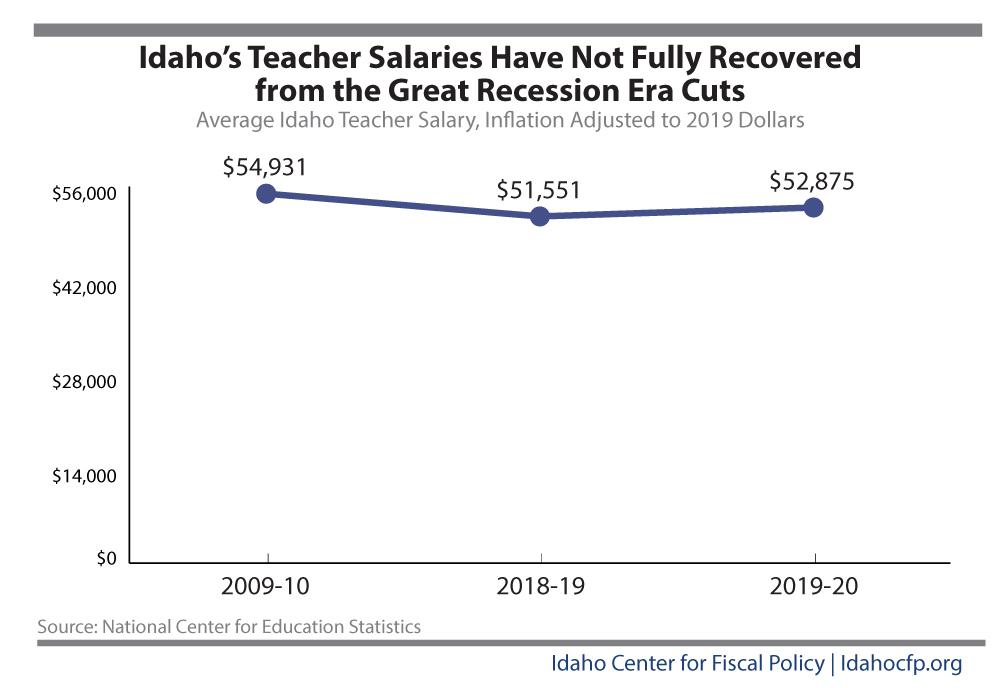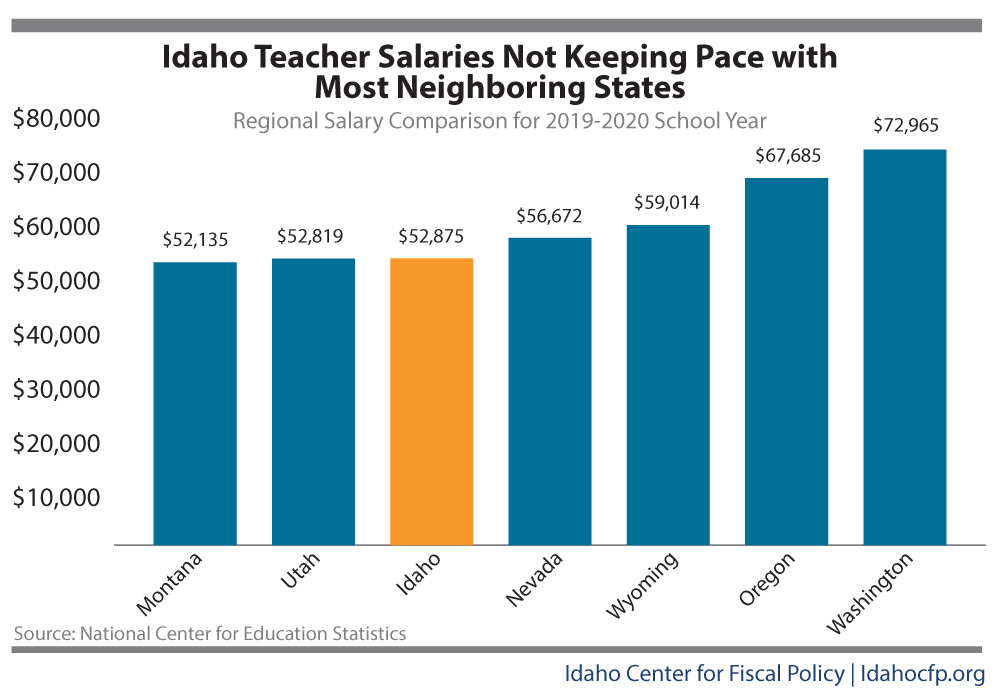Teachers are Idaho’s most important educational assets. They guide children’s learning, helping them reach their full potential from early years up to workforce entry at a time when employers demand highly trained workers. The need for a strong teacher workforce has never been greater. Amid the pandemic, student learning loss has been severe, particularly for students of color and those from families with low incomes, who are already more likely to face steep challenges.
Yet many schools are losing teachers due to inadequate pay amid growing workplace demands. During the COVID-19 pandemic, teachers have been asked to take on more tasks, including online and hybrid teaching and at times have put their own health at risk. Teacher turnover is not the only staffing problem schools have been facing. The loss of classified staff – which includes bus drivers, instructional aids, custodians, substitutes, and others who keep schools running – has been a significant concern for over a decade. Turnover, whether among teachers or classified staff, is costly to districts and students alike. Now more than ever, Idaho schools need stable state funding to ensure they can pay competitive teacher and staff salaries.
Idaho data leading up to the pandemic show that teacher pay in Idaho never recovered from the Great Recession and, as a result, the state continues to lose teachers to neighboring states, especially in border communities. This is a solvable problem, as we examine below. State lawmakers can invest unanticipated revenue from this budget year in adequate pay for teachers and classified school staff members.
Idaho Teacher Pay Never Recovered from the Great Recession

Teacher pay in Idaho remains lower than the inflation-adjusted levels seen before the Great Recession – when revenue losses resulted in significant pay cuts. The average teacher salary fell from about $55,000 in 2009 to less than $53,000 in 2019 (in inflation-adjusted dollars). Making matters worse, teachers’ salary losses have occurred alongside sharply rising rents and home prices. Idaho rents have increased by a staggering 32 percent from June 2020 to June 2021, with average rents going from $888 in June 2020 to $1,091 in June 2021.1
Despite these broader trends, Idaho’s entry-level teachers have seen some improvements in pay. Over the past few years, Idaho lawmakers have implemented the Teacher Career Ladder, a new pay scale for teachers that increased entry-level (or first rung) salaries from $31,000 to $40,369.2 However, over the same period, veteran teachers in Idaho have not seen the same increases in pay as entry level teachers. The third rung of the career ladder was not passed until 2019, and has not yet had a significant impact on the salaries of Idaho’s most experienced teachers.
Idaho’s Teacher Salaries are Failing to Compete with Most Neighboring States

Unlike Idaho teachers, K-12 educators in most neighboring states are getting the salary increases to keep up with rising living costs. The difference in teacher salaries is greatest in border communities like the Panhandle region (which shares a border with Spokane, Washington), the Western Treasure Valley (where teachers can find work in Ontario, Oregon), or the Teton region of eastern Idaho (near the border with Wyoming). Teacher salaries in Washington, Oregon, and Wyoming grew by an average of 12 percent between the 2009-2010 and 2019-2020 school years. Meanwhile, Idaho’s salaries fell by two percent in the same time period. If policymakers do not increase funding for teacher pay, salaries will continue to lose ground to neighboring states – further incentivizing teachers to work in other states.
Idaho is Failing to Hold onto Teachers and Other K-12 Staff
Teacher retention rates and retention for other school staff are not strong despite the considerable cost of recruiting, hiring, and training new teachers and staff. The statewide average retention rate for traditional public schools was 84 percent in 2020, which is also the nationwide average.3 Public charter school teacher retention is higher, however, a much smaller share of children attend this type of school.
As teacher retention on the whole remains middling, an increasing number of teachers are achieving certification through non-traditional means that may not require teacher mentorship. Alternative certification is a stopgap measure in addressing retention because teachers who enter the profession through alternative routes are more likely to leave the profession after a few years.4 This rise in alternative certification is indicative of the drastic need for more educators. This is especially true in Idaho’s rural communities where the teacher shortage is most acute.
Idaho schools are also losing classified staff, which makes it difficult to keep schools running. In the past decade, more than 20 percent of classified staff members have left their position annually and retention of classified staff has averaged less than 79 percent. These staff losses became especially problematic in the height of the coronavirus pandemic, when some schools were forced to close due to staff departures.5 With typical classified staff salaries around $10 per hour for bus drivers or kitchen staff, schools are often unable to compete for labor when local industries pay considerably more (and when other wages are rising in the recovery economy).
Improving classified staff retention through increased pay would benefit children directly, particularly children who were most likely to feel the harms of pandemic related learning losses. Teacher aids, who are considered classified staff, provide crucial one-on-one and small group supports for children as they work to catch up on lost learning.
Idaho Lawmakers Can Invest in Teachers and K-12 Staff
Idaho is uniquely positioned to leverage unanticipated revenue in this budget year to raise teacher pay and make Idaho’s teacher salaries competitive now and into the future. Today, more than ever before, Idaho’s students need committed, high-quality teachers as they recover from the pandemic and related learning losses. Idaho lawmakers should invest state dollars and American Rescue Plan Act funds to increase classified staff pay and hire new staff to provide much-needed educational supports as Idaho students work to regain lost skills.
By fairly compensating teachers and classified staff, Idaho can use our strong revenues today to pay it forward to the next generation of Idahoans. Children, teachers, and taxpayers will ultimately benefit if we address teacher and staff turnover now, by paying our teachers and staff a wage that allows them an adequate standard of living in our fast-growing state and removes incentives to move to neighboring states.
- Apartment List, rental prices. Accessed on August 1, 2022, at https://www.apartmentlist.com/research/category/data-rent-estimates
- Idaho Code: 33-1004B and Idaho State Board of Education, Career Ladder Proposal, Accessed at: https://boardofed.idaho.gov/resources/idaho-teacher-career-ladder/
- Idaho teacher retention data provided by the Idaho State Department of Education. Nationwide, charter schools have lower teacher retention rates than traditional public schools. This is because charter schools typically hire younger and more inexperienced teachers and are more likely to serve hard to reach populations. However, in Idaho this trend is reversed because Idaho charter schools typically serve more affluent students who have less barriers to opportunity. See the Center on Reinventing Public Education Brief, “Teacher Retention in Charter vs. District Schools,” Summer 2010, Accessed at: https://www.crpe.org/sites/default/files/brief_ics_Attrition_Aug10_0.pdf
- Idaho State Board of Education, “2018 Teacher Pipeline Report”, Accessed at: https://boardofed.idaho.gov/resources/2018-teacher-pipeline-report/
- Idaho Ed News, “Districts Face Staff Shortages with Return to Full-Time,” February 15, 2021, Accessed at: https://www.idahoednews.org/top-news/districts-face-staff-shortages-with-return-to-full-time


